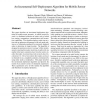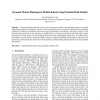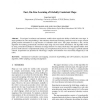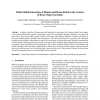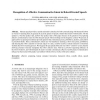123
click to vote
AROBOTS
2002
15 years 17 days ago
2002
Abstract. To realize dynamically stable walking for a quadruped walking robot, the combination of the trajectory planning of the body and leg position (feedforward control) and the...
121
Voted
AROBOTS
2002
15 years 17 days ago
2002
We present an approach to path planning for humanoid robots that computes dynamically-stable, collision-free trajectories from full-body posture goals. Given a geometric model of t...
105
Voted
AROBOTS
2002
15 years 17 days ago
2002
This paper addresses the problem of tracking multiple targets using a network of communicating robots and stationary sensors. We introduce a Region-based Approach which controls r...
124
Voted
AROBOTS
2002
15 years 17 days ago
2002
This paper describes an incremental deployment algorithm for mobile sensor networks. A mobile sensor network is a distributed collection of nodes, each of which has sensing, compu...
141
click to vote
AROBOTS
2002
15 years 17 days ago
2002
The potential field method is widely used for autonomous mobile robot path planning due to its elegant mathematical analysis and simplicity. However, most researches have been focu...
123
click to vote
AROBOTS
2002
15 years 17 days ago
2002
To navigate in unknown environments, mobile robots require the ability to build their own maps. A major problem for robot map building is that odometry-based dead reckoning cannot ...
138
Voted
AROBOTS
2002
15 years 17 days ago
2002
In robotics, the idea of human and robot interaction is receiving a lot of attention lately. In this paper, we describe a multi-modal system for generating a map of the environment...
98
Voted
AROBOTS
2002
15 years 17 days ago
2002
Human speech provides a natural and intuitive interface for both communicating with humanoid robots as well as for teaching them. In general, the acoustic pattern of speech contain...
101
Voted
AROBOTS
2002
15 years 17 days ago
2002
Abstract. We describe a new method for representing human movement compactly, in terms of a linear superimposition of simpler movements termed primitives. This method is a part of ...

